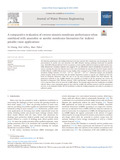JavaScript is disabled for your browser. Some features of this site may not work without it.
| dc.contributor.author | Huang, Yu | |
| dc.contributor.author | Jeffrey, Paul | |
| dc.contributor.author | Pidou, Marc | |
| dc.date.accessioned | 2022-11-29T10:42:38Z | |
| dc.date.available | 2022-11-29T10:42:38Z | |
| dc.date.issued | 2022-11-18 | |
| dc.identifier.citation | Huang Y, Jeffrey P, Pidou M. (2022) A comparative evaluation of reverse osmosis membrane performance when combined with anaerobic or aerobic membrane bioreactors for indirect potable reuse applications, Journal of Water Process Engineering, Volume 50, December 2022, Article number 103295 | en_UK |
| dc.identifier.issn | 2214-7144 | |
| dc.identifier.uri | https://doi.org/10.1016/j.jwpe.2022.103295 | |
| dc.identifier.uri | https://dspace.lib.cranfield.ac.uk/handle/1826/18750 | |
| dc.description.abstract | The filtration performance and fouling behaviour of reverse osmosis (RO) membranes was investigated for the post-treatment of aerobic (Ae) and anaerobic (An) MBR effluents treating municipal wastewater for potable reuse. Both MBR effluents followed by RO can produce a water quality sufficient for indirect potable water reuse, while fluorescence excitation-emission scan suggests RO can effectively remove disinfection by-products precursors, ensuring the safety for chlorine based reuse water distribution by rejecting the dissolved organic matters in MBR effluents. AnMBR effluent leads to more fouling when compared to the AeMBR effluent with an average membrane fouling resistance of 12.35 × 1013 m−1 and 8.97 × 1013 m−1. Elemental analysis and membrane surface imaging results demonstrate that the foulant deposition sequence is organic and colloidal at first, followed by inorganic substances, while TOC and Ca are the most deposited foulants from both effluents. The unremoved ammonia in the AnMBR effluent may partially go through in the RO permeate and exceed the threshold in Singapore's PUB NEWater standard, while experiencing a significantly higher deposition rate of 13.8 % than the nitrate (0.02 %) from the AeMBR effluent. The findings suggest that the combination of AnMBR with RO offers a more sustainable approach than with the AeMBR but nutrients removal, with the potential of recovery, is recommended before the RO membranes to limit the fouling propensity and achieve a permeate of sufficient quality. | en_UK |
| dc.language.iso | en | en_UK |
| dc.publisher | Elsevier | en_UK |
| dc.rights | Attribution 4.0 International | * |
| dc.rights.uri | http://creativecommons.org/licenses/by/4.0/ | * |
| dc.subject | Aerobic | en_UK |
| dc.subject | Anaerobic | en_UK |
| dc.subject | Fouling, membrane bioreactor | en_UK |
| dc.subject | Reverse osmosis | en_UK |
| dc.subject | Water reuse | en_UK |
| dc.title | A comparative evaluation of reverse osmosis membrane performance when combined with anaerobic or aerobic membrane bioreactors for indirect potable reuse applications | en_UK |
| dc.type | Article | en_UK |
Files in this item
The following license files are associated with this item:
This item appears in the following Collection(s)
-
Staff publications (SWEE) [2827]

